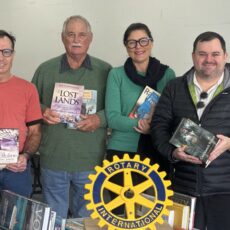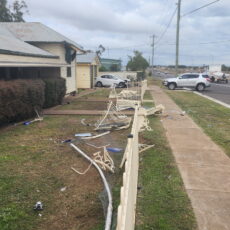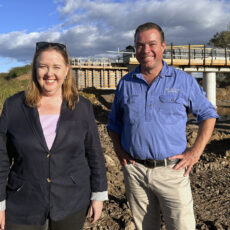By Richard Barry OAM
I’ve been asked to write an article on the Army of the Republic of Vietnam (ARVN) for Vietnam Veterans’ Day.
BRIEF HISTORY
The ARVN composed the ground forces of the South Vietnamese military from its inception in 1955 to the fall of Saigon on April 30, 1975. The soldiers of the ARVN not only suffered defeat on the battlefield, but they were also treated extremely harshly by the victorious Vietnamese communists. They received little respect from their allies and have largely been written out of historical accounts of the war.
At the ARVN’s peak, an estimated one in nine citizens of South Vietnam were enlisted, composed of Regular Forces and the Popular Forces militias. It is estimated to have suffered 1,394,000 casualties (killed and wounded) during the Vietnam War.
The ARVN began as a post-colonial army that was trained by and closely affiliated with the United States and had engaged in conflict since its inception. During the American intervention in Vietnam, the ARVN was reduced to playing a defensive role with an incomplete modernisation, and transformed again following Vietnamisation, it was up-geared, expanded, and reconstituted to fulfill the role of the departing American forces.
However, the withdrawal of American forces by Vietnamisation meant the armed forces could not effectively fulfill all of the aims of the program and had become completely dependant on U.S. equipment since it was meant to fill the departing role of the United States. Unique in serving a dull military – civilian administrative purpose, in direct competition with the Viet Cong, the ARVN had also become a component of political power and suffered from continual issues of political loyalty appointments, corruption in leadership, factional in fighting, and occasional open internal conflict.
After the fall of Saigon to North Vietnam’s People’s Army of Vietnam, the ARVN was dissolved. While some high-ranking officers had fled the country to the United States or elsewhere, thousands of ARVN officers were sent to re-education camps by the communist government of the unified Socialist Republic of Vietnam. Five ARVN generals died by suicide to avoid capture. (John Pilger, 2001 Heroes. ISBN 978-0-89608-666-1 and Casualties – US vs NVA/VC Archives)
Brigadier S.P. Weir, commander of the First Australian Task Force (1ATF) from September 1, 1969 to May 31, 1970, expressed the concerns of many 1ATF soldiers when he remarked that:
“Some of these (ARVN Regional Force) companies were so idle, so corrupt, so poor. There were cases where they tried to kill our advisors – where they were infiltrated by Viet Cong – [where] our fellows were ambushed … it was terrifying … in some cases – not in all cases, but sufficient to make it a worry.”
The men of 1ATF were often critical of the ARVN troops they saw in Phuoc Tuy Province but 1ATF troops tended to see the worst performing ARVN filled units.
Monash University academic Nathalie Huynh Chau Nguyen wrote in 2016:
“After the war ARVN soldiers, especially officers, were subjected by the victorious communists to even harsher penalties than civilians,
including years of forced labour and indoctrination and starvation; those who survived and didn’t manage to escape to the west were treated with contempt and discrimination which were even extended to their children and grandchildren.
The main South Vietnamese Military cemetery at Bien Hoa was vandalised and virtually abandoned until recent years. Even in death the soldiers were treated as puppets, not people.
ARVN did fight, and did take casualties. We may never know the exact numbers, but around quarter of a million service personnel died and about three times that number were wounded. Compare that with the 58,000 American forces, and just over 500 Australian service personnel officially regarded as killed in action. It’s simply not true that the South Vietnamese were shirking the battle. In the last years of the war, after the Americans and their allies had withdrawn, the South Vietnamese forces lost more casualties in a year than the Americans had for the entire war.”
PERSONAL EXPERIENCE
I do not recall much being said about ARVN during our intense training leading up to being sent to South Vietnam. Yes, we were aware of their existence, however, in the main we carried out operations well away from them and to some extent the Americans. I do not recall any Vietnamese being allowed on the big base at Nui Dat. As we can’t pick a Victorian from a Queenslander how were we supposed to pick a South Vietnamese from a North Vietnamese?
Behind the Vietnamese lay 3000 years of history. A chronicle of centuries peppered with invasions, oppression, wars, massacres, famine and unlikely victories against impossible odds. The Vietnamese had learned that life was a constant struggle, and enemies were to be expected everywhere.
Soldiers in the ARVN were paid $20 a month: even their generals received less pay than an Australian infantryman. A general, a commanding officer responsible for the security of the country, was paid less than a bar girl, or a taxi driver, less than an interpreter or a housemaid. But these same soldiers were all expected to fight and die in the service of a country that valued them so little.
Perhaps the saddest part of all was that the Vietnamese themselves could not understand why America was there, why Australia was there.
In 2000, we were flying to China. During the night I started up a conversation with a Vietnamese lady who lived in Australia. She taught English to Vietnamese students. She asked if I had visited Vietnam and I said I had in 1969. She immediately knew I was in the army at the time and to my surprise she revealed she fought with the communist North. She wanted to know why Australia was in Vietnam fighting with the Americans. At the time I couldn’t provide an adequate answer. Then she said they were always wary of the Australians because we were extremely patient soldiers and excellent bushmen more especially at night ambushes – unlike the Americans whom she said were very noisy!
When I went back to my seat I tried to envisage what it would be like if the same situation occurred back home where foreign troops invaded our country, hassled our families, trampled our crops, burned dwellings and frightened everyone.
Our section had an experience with the ARVN in July 1969. I was one of six diggers from Tracker Platoon (6RAR) tasked to leave Fire Support Base Thrust and proceed to the village of Dat Do past The Horseshoe just below the Long Hai mountains and about 12 kilometres south of Nui Dat. The rest of the section were sent to Dai Doi 701 (Tam Phuoc). It was only a few weeks previous that 12 Platoon (5RAR) suffered many casualties from mine explosions at Dat Do. Around Dat Do (population then was 11,654. In 2019 the census for the district was 75,530). Australian engineers built a ring of bunkers to protect the villagers from marauding Viet Cong. Observation Posts (approximately seven metres high) were also constructed about 500 metres apart and were manned by the local militia under the guidance of ARVN. The ARVN were doing their best but it was obvious to me they were mostly ignored by the locals.
The Vietnamese troops in question formed part of the Regional and Local Force and seem to have a complete disregard for the ARVN. Dat Do was not in the area of responsibility and permission had to be sought from the South Vietnamese authorities to move in. The villagers were not too impressed with us. We had to carry out unannounced inspections of the Posts. Time and time again we would see the sentry posts vacant, the M60 machine gun (on a tripod) pointing skywards, live grenades on the floor together with unexploded rounds, discarded items of foodstuff and Vietnamese pornographic magazines. Unmanned observation posts were not the only thing the local militia were guilty of in this area.
It was our duty to teach the local troops various skills in weapon handling and general infantry tactics. We also involved ourselves at the checkpoint when the peasants came in from the fields at curfew; checking identification cards as well as the produce on the ox-drawn carts plus any bags etc. Dat Do was a mine-seeded area. The village was generally peaceful by day, but disputed at night by both sides, the Viet Cong and the government forces.
Dat Do was a very hostile village in the early days of Australia’s involvement in Vietnam. At the end of each day, we handed over the control of the checkpoint duties to the ARVN. This unit of Local Force troops were dressed immaculately in tight-fitting uniforms adorned with neat and impressive appendages. They mostly carried side arms with little or no webbing. They spoke no English although I suspect they understood us. They maintained their superiority over the hard-working peasant farmers.
On occasions I witnessed the ARVN raiding baskets of produce from the peasants, without permission or payment. It was good practice to ensure all equipment was secure otherwise it had a tendency to ‘grow legs.’ I was told much later that some of these ARVN groups were infiltrated by local guerrillas/militia that very easily changed sides at the drop of a hat. It was always good practice not to trust anyone unless they were Australian or New Zealand blokes in our Anzac Battalion (6RAR).
We tried to make ourself comfortable in tents erected in the front yard of 615 Company Headquarters (Local Forces) which housed four Vietnamese families. It was a bit disconcerting listening to the occupants consuming hot meals and alcohol and entertaining young women whilst we had to remain silent and alert eating dry rations. I must admit I slept with one eye open all the time we were stationed in that spot. We carried out night ambushes and also checked on the other Local Forces 3/613 Company troops who lived with their families in large bunkers built by 5RAR. It was indeed a very strange atmosphere.
One day an ARVN officer briefed us on possible Viet Cong hiding in a nearby house. It was the same house I’d been watching an old farmer tendering to his tiny patch of corn. That night about 2am we decided to raid the shanty home and had to trample through the corn to gain access. Upon entering the house with rifles drawn we encountered a family all sleeping together on a big raised bamboo bed whilst a bunch of candles flickered beneath a statue of Budda in one corner. The family were frightened and we withdrew after an unsuccessful search.
Next day I spotted the farmer inspecting the damaged corn stalks. He beckoned me over and handed me a corn cob. I took it back and boiled it on my hexamine stove in my canteen.
We had been on dry rations for a long period and the fresh corn gave me a bad case of diarrhoea. The old farmer had the last laugh.
Very often we found ourselves patrolling on mounds between the water-filled rice paddy fields. I felt really sorry for the women and young girls planting individual rice plants in long rows. They stood in water for hours and their back pain must have been unbearable towards the end of the day whilst the men relaxed on little wooden ploughs drawn by oxen to loosen the water-logged soil often with a smoke in their mouth. The women worked extremely hard and I’d stop momentarily to bring a smile to their faces.
An initiative was invented to encourage defection by the Peoples’ Army of Vietnam and the Viet Cong and their supporters to the side of South Vietnam during the war. It was called the CHIEU HOI (OPEN ARMS) program. Deflection was urged by means of a propaganda campaign, usually leaflets delivered by artillery shell or dropped over enemy-controlled areas by aircraft, or messages broadcast over areas of South Vietnam.
Overall, the CHIEU HOI program was considered successful. I recall hearing radio broadcasts from the Armed Forces Vietnam Network (AFVN) Channel 54 Saigon – the station made famous by the movie “Good Morning, Vietnam.” Those who surrendered were known as HOI CHANH and many were often integrated into allied units as Bushman Scouts, operating in the same area where they had defected. Others were used as interpreters. To be honest I was never 100 per cent sure it was the right thing to do.
Whilst patrolling through a rubber tree plantation the signal came through of possible enemy ahead and to go to ground.
I positioned myself at the butt of a tree and in the leaf rubble I found one of the leaflets along with some local currency. The safe conduct pass was noted GIAY THONG HANH which means ‘passport’. On the reverse in Vietnamese, it reads: “Bring your Passport. Now collaborate with the government. Your country will accept you. Kindly welcome. Ensure security. Equal treatment.” This leaflet is now with the Australian War Memorial.
When we all packed up and went home, what happened to these defectors? One can only imagine when the communists’ aggressors arrested them. I regard this as a sad indictment on our military involvement in South Vietnam. They should have been immediately issued with visas to enter our country when we came home more especially when I see what is happening today with regard to illegal aliens!
TODAY
Since 1996 I have been lobbying successive governments to achieve full recognition for some 2500 national service Vietnam veterans from across this nation who were sent home having served less than the ‘required’ days in the war zone. They were sent home (1) having completed their two-year’s service or (2) suffering from severe accidents or terrible diseases. They were not obligated to extend their service and through no fault of their own have not been fully recognised. The campaign continues with overwhelming support. On February 28, 2024 Queensland Senator Paul Scarr stood up in the Senate and delivered a powerful and emotional speech concerning the campaign (I have a copy of the video). A contingent of some 26 Vietnamese people travelled from Sydney to be present in the gallery in Parliament House.
I have supportive letters from these people and I list a few extracts:
“We love the images of Australian medics and teachers and nurses who risked their lives to treat our wounded South Vietnamese soldiers and civilians. With us, indeed, the Australian soldiers (regardless regular or conscript) were our heroes.” (Mr Andy H. Nguyen – president of ARVN/Rangers Association of Victoria Australia Inc).
“Our community have been grateful for the sacrifice of the Australian servicemen regardless the length of service as the risk of losing one’s life could occur in a single day.” (Mr Phung Nguyen – president Vietnamese Community in Australia, SA Chapter Inc).
“The former South Vietnamese government intended to award the Republic of Vietnam Campaign Medal (RVCM) to those men who were prepared to die alongside local South Vietnamese forces in defence of democracy and freedom.” (Mr Cuong Minh VO – president of The ARVN’s Veteran’s Association in Australia – NSW Inc).
“I was a second lieutenant in the ARVN for five years and spent 78 months in many different concentration camps. My former government would have gratefully
awarded the RVCM to former national servicemen in recognition of their sacrifice to protect our motherland.” (Mr Dinh Nguyen – president of The Vietnamese Veterans Association of Victoria Inc).
“The South Vietnamese soldiers were not puppets. They were defeated, but deserve not to be denigrated by both their conquerors and their allies. As we approach Vietnam Veterans’ Day, we would do well to give a thought to our South Vietnamese allies”. (Nathalie Huynh Chau Nguyen).
So, in summary there is and there was both good and bad in any army. The ARVN had a most difficult job in extreme circumstances especially dealing with an enemy within their own ranks plus uninterested Regional and Local Forces. Like any army, ARVN units were generally as good as their officers and their training. Who could tell if they were dealing with a communist sympathiser or a democratic individual. They were defeated, but deserve not to be denigrated by both their conquerors and their allies. It is noted the frustration of the South Vietnamese forces when the US Congress cut support in 1974, while the north continued to receive massive support from the Soviet Union and China. The South Vietnamese forces had arms but no ammunition, equipment but no spare parts. When ARVN soldiers were reduced to three rounds per day, defeat was inevitable.
Many former ARVN are living peacefully in Australia and they are extremely grateful of the Aussie diggers who fought alongside them against oppression in their motherland in the name of freedom and democracy.
They had to serve twelve months in the war before being awarded the Republic of Vietnam Campaign Medal whereas the allies had to serve at least 181 days – 60 days for a cohort of American troops.
These locals had been fighting communists all their life. These Vietnamese people proudly call Australia home and march behind their former flag on Anzac Day.
They have assimilated into our culture without any fuss.
Today, we see our grandkids planning holiday trips to Vietnam – popular as Bali. They send photos of the beautiful countryside back home. Back then there was no time to take in such sights whilst on jungle patrol.
To order photos from this page click here










